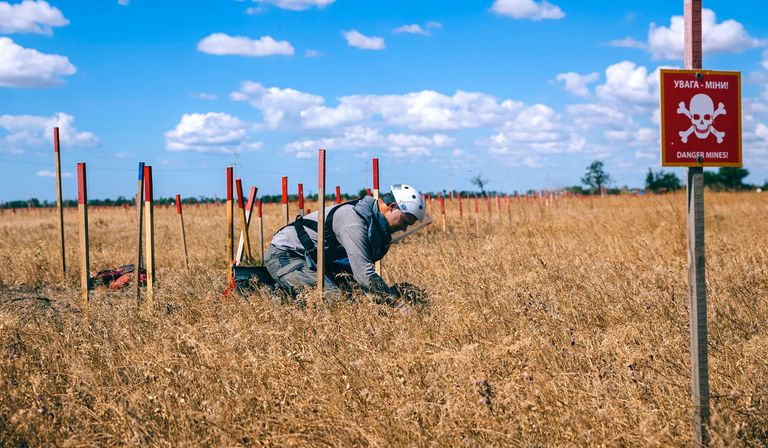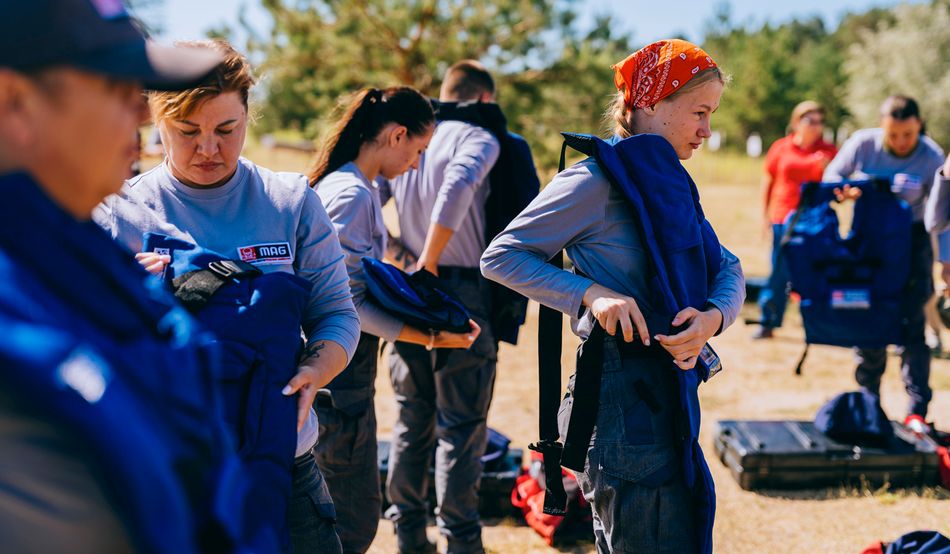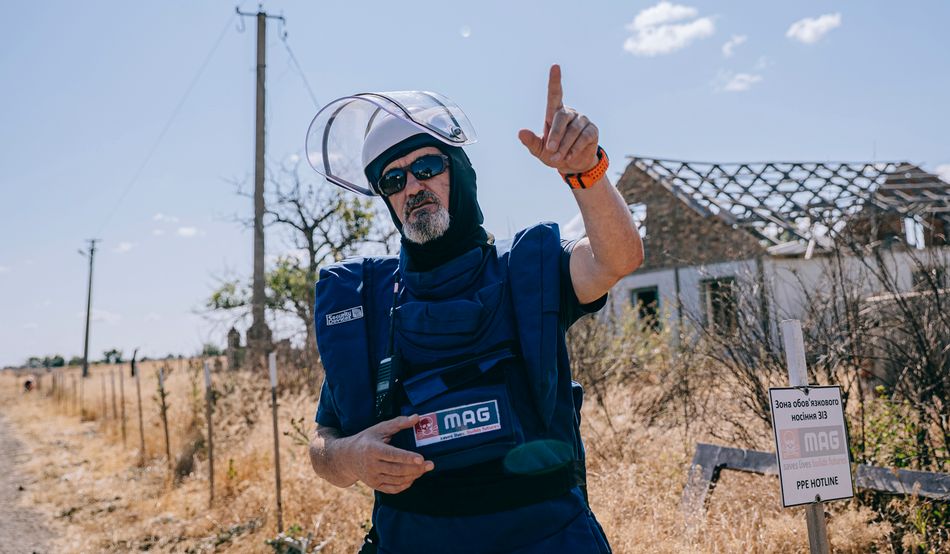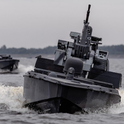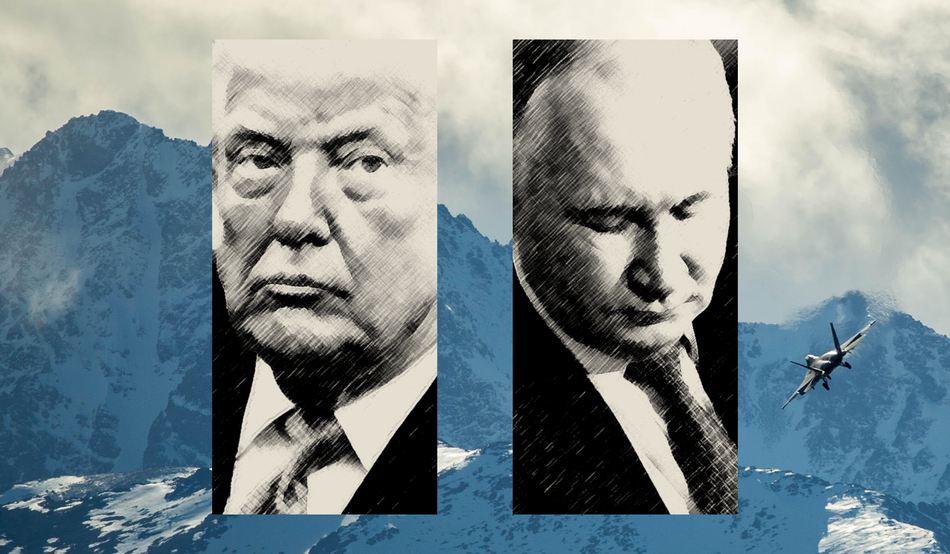There is a type of landmine that springs into the air before detonating, high enough for the deadly arc of shrapnel to reach the vital organs. The idea isn’t new—Germany produced almost two million “Bouncing Betty” S-mines during the Second World War—but the POM-3 is the next generation. Russia developed it and has been using it in Ukraine since 2019. This anti-personnel mine has a seismic detector—no need for a tripwire, just a footstep will do. A little parachute lets it drop into position, then the mine rests on splayed, spring-loaded “feet” and waits for its victim. The whole thing weighs barely more than a kilogram.
Looking at a photograph of the POM-3, taped to a white canvas tent in southeastern Ukraine, it’s hard not to think about the human ingenuity that’s gone into packing the mine with sharp-toothed rings of metal, all with the aim of ripping apart a person.
It’s hard, too, not to find this thing fundamentally wrong. Who knows what might set off that sensor in the future, or who might tread on the pressure pad of the countless buried mines now littering Ukraine’s frontline areas? A soldier, maybe. Later, it could be a farmer. Or perhaps, as happens with awful regularity in Myanmar, Syria and Afghanistan, it could be a child.
The indiscriminate nature of anti-personnel landmines is precisely why they were banned in 1999, when the Ottawa treaty entered into force. Their use, stockpiling, production and transfer were prohibited—a huge victory for the NGOs spearheading the campaign which was, famously, joined by Princess Diana. The result was a 95 per cent reduction in landmine casualties in 15 years. 164 countries signed up—including Ukraine.
Russia has used a lot of POM-3 mines in Ukraine. Deminers need to know what they look like, which is why the picture is taped to a tent, next to maps and charts and work schedules. The tent’s exact location can’t be disclosed, but it’s one of many sites where the Mines Advisory Group (MAG), an NGO with nearly 400 staff in Ukraine, works to remove the “contamination” of war—a catch-all term for everything from cluster munitions to unexploded shells to cannon rounds. And, of course, mines.
It is a staggering task. Estimates are that roughly a fifth of the country—137,055 square km—could be contaminated, prompting claims that Ukraine is the “most mined country in the world”. The impact on its people—from soldiers to farmers—is well-documented. So why, amid all this, is Ukraine turning its back on the landmine ban?
In Mykolaiv, a shipbuilding city twinned with Glasgow, the demining teams set out early: at 6.30am the operations hub is already crowded with people hauling kit bags and toolboxes from the shelves. Minibuses wait to take them out to the little towns and villages which bore the brunt of occupation and fighting in 2022.
At this hour, the heat hasn’t had a chance to set in, but it will; summer temperatures in southern Ukraine can reach the high 30s. This is a land of vineyards, fruit trees, cereal crops. In normal times, a land of abundance.
The crews piling into vehicles are mostly female, a broad mix of ages, and all Ukrainians who have been trained up by MAG. The UK-based charity has been clearing mines and educating people on risks in conflict zones since 1989, and has been in Ukraine since 2022.
On the way to the site, the flat steppe landscape flashes past: golden crops and a cloudless blue sky. Sunflowers and wheat are already high in the fields. This is the black earth, the chornozem, which makes Ukraine such an important food producer.
Where we get out though, the fields lie fallow, hemmed by bright red signs: “DANGER—MINES!”, with a white skull and crossbones for emphasis. Eleven of Ukraine’s regions are mined, though the situation varies: in Kyiv region, where Russian troops were booted out quite early in 2022, much of the deadly detritus has now been removed. But in areas that endured a longer occupation and heavy fighting, mines and unexploded ordnance (UXO) remain a massive problem. It gets worse again closer to the frontlines—north of Sumy and Kharkiv, or down the long eastern front. We can only guess at the situation in occupied Ukraine—though Russia’s well-documented tactic of laying enormous, dense minefields will give some clues.
It’s about 20 miles from the frontline here—the closest these teams will operate—near enough to catch the occasional boom, and, once, to see the smoky trail of an outgoing Himars missile. The safety briefing is extensive: there’s a risk of artillery strikes and, increasingly, drones. MAG’s camps, with the white tents and toilets and vehicles, could be an easy target. But the biggest danger is what could be under our feet. To go into the minefield, we haul on cumbersome flak vests and helmets, and learn what to do if we accidentally stray from the path (“Stop, get attention from staff, and you will be safely extracted”). It’s not a place to be inattentive.
Pepa Elezi is in charge of this site. Tall and bearded, he stalks down the path in his huge blue vest and helmet. “Mine,” he intones, gesturing to wooden pickets marking where anti-tank mines were removed. “Mine. Mine. Mine.”
There is an art to reading a minefield. Elezi has been doing it for two and a half decades. First the non-technical survey—asking locals and looking for evidence of contamination. You piece together what happened: troop movements, positions and duration of fighting all give vital clues. Russian troops attacked the village in the first stage of their invasion, trying to reach Mykolaiv. They dug in and built trenches, before the Ukrainian army came to push them back.
“There was a lot of back and forth. So there’s too much contamination from different arsenals,” Elezi explains. This makes it difficult to use metal detectors: their alarms go off constantly. Luckily, Elezi spotted a fuse early on, through binoculars, and recognised the TM-62 Soviet anti-tank mine. They calibrated the detectors to pick up these mines, and found nine in a row. He’d been able to show the local farmer, who had insisted on grazing her cow on the field, how close the animal had come to stepping on the mine: about 7cm. Demining can be a very slow process, and farmers don’t always want to wait.
Even with the row of mines removed, the field still has to be thoroughly checked for other threats: anti-personnel mines, unexploded shells, multiple launch rocket systems, mortars. The row of partially destroyed houses that forms the village gives an indication of how fierce the battles were in 2022. Later they’ll bring in dogs to sniff out traces of explosives. After more checks and much paperwork, the field can be officially declared safe and handed back to the local community.
“Painstaking” doesn’t come close to describing demining. When conditions demand full excavation, it’s “like gardening on steroids”, says MAG’s country director, Jon Cunliffe. At a training site in a forest clearing, new recruits kneel in the dusty ground, thick visors over their faces and the sun blazing down on them. It’s nearly 30°C. Operations stop at 37°C. Armed with a Minelab F3 metal detector, trowel and shears, they must find the items trainers have hidden earlier.
Tripwires are the scariest prospect: almost invisible and easy to trigger
Yurii, a 35-year-old former soldier, moves his metal detector slowly over the small patch of dusty soil marked out at his feet. The noise of the forest around—birdsong, crickets, the steppe wind—almost drowns out their quiet conversation. Then a ping. Yurii crouches, brushes dirt away, and lays down a red triangle to indicate his find—a bit of scrap metal. Every movement is slow and measured.
Tripwires are the scariest prospect: almost invisible and easy to trigger. The trainees search for these on their knees, running a thin poker, like a knitting needle, through the grass, lifting it ever so slowly to head height, pulling it back. The concentration is intense.
In the last batch of 22 trainees, only two didn’t pass. Some go too fast, some are afraid and have to be pushed a little. Undoubtedly, it’s physically challenging work, but also involves a strange combination of monotony and fear.
Yurii, though, is not bothered by any of this; he spent nine years in the army. The demining vest, I guess, is light in comparison to military body armour? “Oh, five times lighter,” he nods. He has four children, all girls, and left the army after his wife died.
“I was advised to find something new, where I could use my skills and also do something good,” he says. His hobby, he reveals, is repairing classic cars, and demining’s not dissimilar: the careful, close attention to small details.
“A deminer makes a mistake only once,” Yurii added. “So I understand why it needs to be so precise.”
Second youngest in the group, Liza Khazova is just 19. Her blonde plaits make her look even younger—but looks can be deceiving. “I like all this,” she says, briskly. “Where there’s danger, I’m drawn towards it.”
She’d considered joining the army, but ended up in demining. “I think it’s very important work, and will be after the war too. We’ll have to clean it all up, so people don’t get killed.”
The reaction of Liza’s friends to her new profession had not been entirely positive. “Many of them said I’m an idiot, because I went to do a job that isn’t safe,” she says. “Whatever, I like it, and I do what I want. I won’t explain to anybody.”
Anastasiia Remykhailo has a similar story. A year older than Liza, she studied law before the invasion. Friends and family are “50:50” about her decision to work for MAG, she says. “Look, they’re worried, it’s scary… but if you do everything properly, it’s fine.”
Many of the trainees come from Balakliya, a town in Kharkiv region that is badly affected by mines and UXO. Viktoriia is 48 and says her main motivation was to escape from computer work after many years as a schoolteacher.
“I decided to be in nature, communicating with adults. Not teenagers,” she laughs.
Do her former pupils must think it’s pretty cool, that’s she’s become a deminer?
“Oh, I didn’t tell them,” Viktoriia says. “Maybe they will say that later!”
She believes it will take 100 years to clean up Ukraine, but insists she is “optimistic—of course.” Her husband, a veteran with a spinal injury from the war, is joining MAG as a driver. “He wanted to be useful,” she says.
MAG is looking to recruit more veterans, and the number of staff with disabilities is growing. Men of draft age (25 to 60) can be conscripted and the demining teams have lost members this way, though occasionally they’re granted exemptions.
At the edge of another minefield, Belgian Malinois dogs—beautiful big hounds, similar to a German Shepherd but with comically pointed ears—bound around their two female handlers. John Parra, a Colombian instructor with APOPO, a charity that partners with MAG in Ukraine, pulls out a jar of TNT and uses pincers to take a tiny amount of powder. This is the test for Koral and Charlie, the dogs with Karina Buchma and Daryna Hromychenko, and within a few minutes they’ve found where he put it.
“Each dog has their own character and attitude,” says Buchma as she unfurls the 25m leash. She’s been in the job for nearly two years. “It’s not that easy to make contact. Every dog is super different, just like humans.”
Koral rolls over for a belly rub and Buchma laughs and complies—but as soon as she gives an order, the dog is focused, perfectly attuned to her.
During training in Cambodia, Buchma recalls, “my dog was the first to find a mine there, an anti-tank mine, and I was so proud of her.” She worries about the dog “more than about myself”, but the risk to the animals is extremely low, and APOPO say none have ever been hurt.
Among the threats here are unexploded 220mm mortars. The failure rate of older Soviet munitions is estimated at 10 to 30 per cent but, just because it didn’t go off, that doesn’t mean it won’t. The dogs, specially trained from a young age, can each cover up to 1,500 square metres a day—and when the emphasis is on returning land to productive use quickly, this is a godsend. There is typically a huge difference between what is suspected as contaminated, and what really is—in Croatia, one expert explains, just 0.5 per cent of suspected land actually needed clearing, and the country will likely be declared mine-free within the next 12 months. For Ukraine that is a very distant dream: decades at least, and conservative estimates talk of centuries.
Talking to civilians in Yavkyne, a village where the red warning signs are visible just behind the community centre, it’s clear how exhausting it is to live surrounded by this invisible threat. The place is idyllic—the summer air is alive with birdsong and butterflies. But near the carefully tended rose garden, there’s a scar on the asphalt, a starburst shape made by a cluster bomblet. Someone has painted it in bright colours. Nearby is the building where people gathered to charge their phones when power was cut. In March 2022, the spot was hit by cluster bombs. Three died, 13 were injured.
Inside the community centre, children are stamping their feet furiously in response to a picture of a petal mine. Its “wings” look like a butterfly or a green petal on the ground, making it attractive to children. A real butterfly comes on the screen and they all clap—“safe”.
This is MAG’s community education programme, and the teacher Dmytro has all the kids engaged. The next slide shows ripped-open toys with strange objects inside them. Some kids stamp, some clap.
“Absolutely, this is not safe,” he says. “Unfortunately, there are very bad people”.
Nobody should have to explain to children that soldiers sometimes booby-trap toys with explosives, but they have to learn, and Dmytro explains afterwards that he tries to find a balance. “Look, we’re talking about a dangerous situation. But… you have to do it gently.”
Though only 26, Dmytro is also a former soldier, discharged in 2023. He wanted to do something useful and found MAG. “It’s actually the best job I ever had in my life,” he beams.
The kids have gone to play outside but, as the parents watching them explain, their children don’t play in the way they used to. With the areas around the village potentially mined or littered with UXO, they can’t be allowed to roam free, and in the summer, this is particularly painful.
“There’s a lovely place nearby, a reservoir, and we’d go for walks there,” says Tatiana, as her children bounce around us noisily. “But now we can’t go there, it’s dangerous.”
They look like a butterfly on the ground, attractive to children
Over a few days with MAG’s teams, the overwhelming impression is just how painfully slow and difficult this work can be, and the enormity of the problem. This is why Ukraine’s decision to “suspend” its obligations to the Ottawa treaty has been met with such confusion by the campaigners who instigated the ban in the 1990s.
“It’s a decision that’s not just illegal, but damaging for their own people,” says Tamar Gabelnick, director of the International Campaign to Ban Landmines. “Why go to this outdated, old-fashioned weapon that’s been proved to be of not any great military utility?”
But for many Ukrainians, the answer is simple: Russia. Facing an enemy that is not constrained by the treaty—Russia, along with the United States and China, never signed up—and that seems intent on crushing Ukraine for ideological reasons, the government says this is a reasonable step.
“To protect our land from occupation, and our people from horrific Russian atrocities, Ukraine has made the difficult but necessary political decision to stop the implementation of irrelevant obligations under the Ottawa Convention,” the official statement read. It argues that the radical change in circumstances, and the right to self-defence under the UN Charter, permit Ukraine to make this move.
“We are not talking about withdrawing, creating landmines, or supplying landmines for countries all over the world,” Ihor Bezkaravainyi, deputy minister of economy, environment and agriculture, says in a video call. “No—we just took this step for our own needs.”
Bezkaravainyi is no stranger to the threat posed by landmines: he was injured in 2015 while serving as a soldier, losing part of his leg in an anti-vehicle mine explosion. It’s a reminder that Russia was deploying mines on Ukrainian territory long before the full-scale invasion of 2022.
But international outrage has been loud since the announcement in June—not just directed at Ukraine, but also at the five other nations now withdrawing from the convention. Estonia, Latvia, Lithuania, Poland and Finland have all cited security concerns related to Russia, and when put to a vote in their respective parliaments, withdrawal won massive support: in Lithuania the vote was 107 to 0.
Bezkaravainyi says this makes sense strategically, because “lessons have been learned” in the Baltic states—tiny countries with an aggressive neighbour. “With small infantry groups, it’s impossible to save your border if you don’t have that type of weapon,” he concludes, adding that those in the west may not understand how much the situation has changed.
It’s a point echoed by Eoin McNamara, a postdoctoral fellow at the Finnish Institute of International Affairs. “The hope is that these will never be used, if border fortifications are nasty and brutish enough that the Russians will not take the risk of encroaching,” he explains. “Anti-personnel mines on the border is just one dimension. We’re looking now at stronger in-place deterrence… [including] a battle group opening up in the Arctic… it’s cautious, it’s slow-moving, but it’s happening… anti-personnel mines play a role in this regard.”
There is little agreement on either the legality of what Ukraine is trying to do or the military utility of anti-personnel mines—but it’s hard to dispute the role that Russian minefields played in blocking Ukraine’s 2023 counteroffensive. Royal United Services Institute analysts Jack Watling and Nick Reynolds concluded that “extensive” Russian minefields “pose a major tactical challenge to Ukrainian offensive operations”. Ukraine wants the same tool at its disposal.
The six states stepping back from the Ottawa treaty argue that they’ll use anti-personnel mines responsibly: never against civilians, always carefully mapped, and in some cases, self-neutralising. Those who fought hard to ban landmines say that these promises are impossible to guarantee. Tamar Gabelnick is among them. “You can’t be 100 per cent sure where the mine is, [even] if somebody mapped it exactly right, so you treat each square metre as if the mine might have moved within it, and it’s the threat in the meantime,” she says.
The image of Princess Diana in an Angolan minefield in 1997 gave the campaign a huge, global boost—and the man walking alongside her was Paul Heslop, then a mine removal expert. These days he’s in Kyiv, the senior mine action adviser to the United Nations.
“Mines are an indiscriminate weapon that cause horrific casualties,” Heslop says. “As somebody who spent 30 years clearing mines, I’m very disappointed to see that the treaty is coming apart at this point.”
But, he adds, “I am not a Lithuanian or a Pole or a Latvian or a Finn, who may find that my land is no longer mine and is under the control of an aggressive neighbour.”
Living in Kyiv perhaps gives you a more nuanced perspective on the kinds of decisions people are grappling with in this region, Heslop suggests, and he points out that the withdrawal was a democratic decision, voted on in parliament, in each of the six countries.
MAG, which this year won the coveted $3m Hilton Humanitarian prize in recognition of its peacebuilding and mine-clearance work, was a founding member of the campaign that secured the landmine ban; as such, it is also a joint recipient of the Nobel Peace Prize, awarded in 1997 to recognise that extraordinary achievement. The prize letter, in Norwegian, is proudly displayed in the organisation’s Manchester office.
However, the majority of MAG’s staff in Ukraine are local, and some of their international staff have been there since 2022: they too spend their nights in shelters as explosions shake the cities, so are keenly aware of the conundrum Ukraine faces.
It is a difficult line to tread, admits the charity’s director of policy and strategic partnerships Josephine Dresner. “When you see the impact of landmines and other UXO, you’re really conscious of how they affect civilians, and how long term the impact is,” she says. “At the same time, when you’re working in a situation like Ukraine and you see the impact of the invasion, you’re very aware of how difficult the decisions are that they have to make.
“I would never condemn a person in Ukraine for feeling how they do about the use of landmines, but I wouldn’t justify it myself, because I can’t.”
MAG’s position is that it must remain consistent, which means saying that “no use of landmines is acceptable in any circumstance, at any time, and we have to say that to any country… we have to say the same to people in Mali as we do to people in Ukraine”.
A young deminer on the training site perhaps sums up the dilemma. He comes from the area around Izium in the northeast, a place torn apart by Russian invasion, brutal occupation and, now, by landmines and UXO. Asked about the countries withdrawing from the treaty, he says it was a bad move. “They should adhere to it, not spread these dangerous mines.”
And when you’re facing Russia? He pauses.
“Well, when you’re facing Russia? Then you may use them.”
